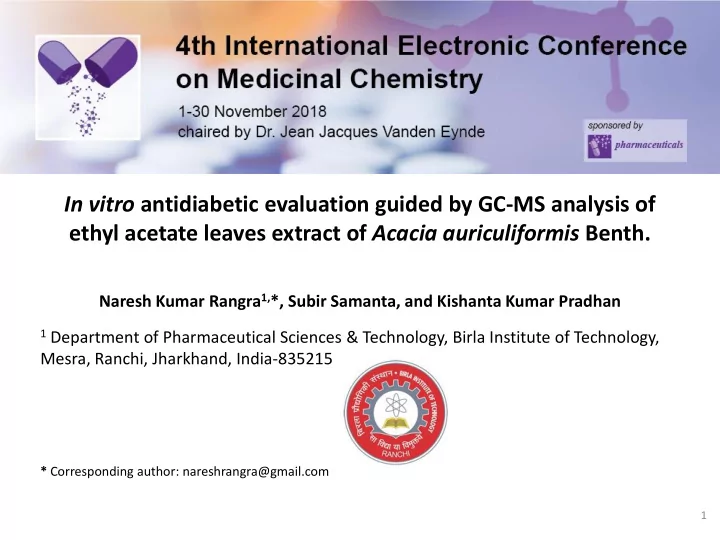

In vitro antidiabetic evaluation guided by GC-MS analysis of ethyl acetate leaves extract of Acacia auriculiformis Benth. Naresh Kumar Rangra 1, *, Subir Samanta, and Kishanta Kumar Pradhan 1 Department of Pharmaceutical Sciences & Technology, Birla Institute of Technology, Mesra, Ranchi, Jharkhand, India-835215 * Corresponding author: nareshrangra@gmail.com 1
In vitro antidiabetic evaluation guided by GC-MS analysis of ethyl acetate leaves extract of Acacia auriculiformis Benth. Graphical Abstract 2
Abstract: Acacia auriculiformis Benth. is an evergreen shrub traditionally used as a remedy in the cure of itching, aches, allergy, rheumatism, and sore eyes. But recently, this shrub has been explored for antidiabetic activity. Here in this work, we have attempted to evaluate various leaves extracts of Acacia auriculiformis Benth. for α - glucosidase assay and α -amylase assay and thereafter the bioactive ethyl acetate leaves extract was subjected to GC-MS analysis. The in vitro antidiabetic evaluation showed promising results. The % inhibition of ethyl acetate leaves extract in the α - glucosidase assay and the α -amylase assay was found be 94.259% and 95.259% respectively, at a concentration of 10 μg /ml. The LC-MS results revealed the presence of phenolic compounds (phenol, 2,4-bis(1,1-dimethylethyl); 2,4-Ditert- butylphenol) and various esters (hexadecanoic acid, methyl ester; 1,2- benzenedicarboxylic acid, butyl octyl ester; hexadecanoic acid, 2,3 bis[(trimethylsilyl)oxy]propyl ester). Those compounds could be responsible for the desired antidiabetic activity. Keywords: Acacia auriculiformis Benth.; Antidiabetic activity; α -Glucosidase Assay; α -Amylase Assay; GC-MS. 3
Introduction • Diabetes mellitus (DM) is a complicated chronic systematic disorder usually assisted by basic metabolic disorders like hyperglycaemia, hypertriglyceridemia and hyperinsulinemia. • It has been estimated that by the end of 2035, the number of DM patients will be increased from 422 million to 592 million. • DM is mainly classified into two types: type1 diabetes mellitus and type 2 diabetes mellitus. • Type 1 diabetes mellitus is identified by deficiency in insulin because of the destruction of β -cells of pancreas and is a rare disease. • Whereas the type 2 diabetes mellitus is characterized by deficiency in insulin secretion and insulin resistance. 95% of the individuals are affected by type 2 diabetes. • From ancient time, natural products including herbal formulations, crude extracts and isolated phytoconstituents are being used in the treatment of various human ailments including diabetes mellitus. 4
• Acacia auriculiformis A. Cunn.ex Benth. belonging to family Mimosaceae or Fabaceae, is an ornamental, evergreen shrub widely distributed in India as well as in several parts of world. • It was traditionally used as a medical ailment for aches, sore eyes, itching, allergy and rheumatism . • The phytochemical investigations disclose the presence of tannins, flavonoids, and triterpenoidal saponin glycoside in the plant extracts . • The phytochemical extracts and phytoconstituents of Acacia auriculiformis has been evaluated for various pharmacological activities like cestocidal, anti-mutagenic, antidiabetic activity, hepatoprotective, antioxidant, spermicidal, wound healing, CNS depressant activity, chemopreventive, antimicrobial, antimalarial, and anti-filarial. • Here, in this work an attempt has been made to highlight the in vitro antidiabetic activity of leaves extracts of Acacia auriculiformis Benth. • The gas chromatography-mass spectroscopy (GC-MS) analysis of the bioactive extract was performed to identify the phytoconstituents responsible for respective biological activity. 5
Results and discussion In vitro Anti-diabetic Activity α - Glucosidase Inhibition Assay α - Glucosidase Inhibition Assay 120 100 Ascorbic Acid % Inhibition 80 Ethyl Acetate 60 Hexane Methanol 40 Acetone 20 Butanol 0 Chloroform 0 2 4 6 8 10 12 Concentration 6
α - Amylase Inhibition Assay α - Amylase Inhibition Assay 120 100 Acarbose % Inhibition 80 Ethyl acetate 60 Hexane Methanol 40 Acetone 20 Butanol 0 Chloroform 0 2 4 6 8 10 12 Concentration 7
GC-MS Analysis of the Bioactive Ethyl acetate Leaves Extract 8
Phytoconstituents identified from GC-MS analyis of ethyl acetate leaves extract 9
• The leaves plant extracts showed inhibitory action against α – glucosidase and α– amylase enzymes. • The ethyl acetate leaves extract showed highest % inhibition(94.259% and 95.259%) on α – glucosidase and α – amylase respectively at a concentration of 10 μg /ml. • The carbohydrate metabolism involves α -amylase and α -glucosidase enzymes and therefore these enzymes are considered to be the effective target for in vitro antidiabetic evaluation. • The α -amylase and α -glucosidase inhibition results in prolonged carbohydrate digestion and glucose absorption. • Several drugs like Acarbose, voglibose, metformin and miglitol that inhibit the α -amylase and α -glucosidase enzymes are available in the market. • Acarbose is the first dual enzyme inhibitor i.e. it inhibits both the enzymes. • But the notable side effects of the above enzyme inhibitors are flatulence, abdominal distention, and diarrhea, there is still a need to search the effective and safe inhibitor from natural sources. 10
• The ethyl acetate leaves extract of Acacia auriculiformis Benth. inhibited effectively both the target enzymes which might be due to the presence of specific phenolics. • Further GC-MS analysis of bioactive ethyl acetate extract suggested the presence of phenolic compounds like Phenol, 2,4-bis(1,1-dimethylethyl) and esters like Hexadecanoic acid, methyl ester, 1,2-benzenedicarboxylic acid, butyl octyl ester, Octadecanoic acid, methyl ester, Hexadecanoic acid, 2,3- bis[(trimethylsilyl)oxy]propyl ester and various other compounds like (-)- Loliolide, SS (-)-Vincadifformine, 3-Heptadecanol, Isopropyl myristate, Hexahydrofarnesyl acetone, 7,9-di-tert-butyl-1-oxaspiro(4,5)deca-6,9-diene- 2,8-dione, Docosane, Eicosane, 1-Heptacosanol etc. • From the above-analyzed compounds by GC-MS analysis the phenolic compounds may be responsible for imparting the desired antidiabetic activity. 11
Conclusions • From the present findings, it is concluded that the ethyl acetate leaves extract of Acacia auriculiformis Benth. possess significant antidiabetic activity due to the presence of phenolic compounds. • The GC-MS analysis also revealed the various compounds including phenolics. • This confirmed the correlation of desired pharmacological activity (antidiabetic activity) with the phenolic compounds. • Further, this bioactive extract is being explored for in vivo antidiabetic studies and also the isolation of bioactive compounds from bioactive ethyl acetate leaves extract is in process. 12
Acknowledgments 13
Recommend
More recommend